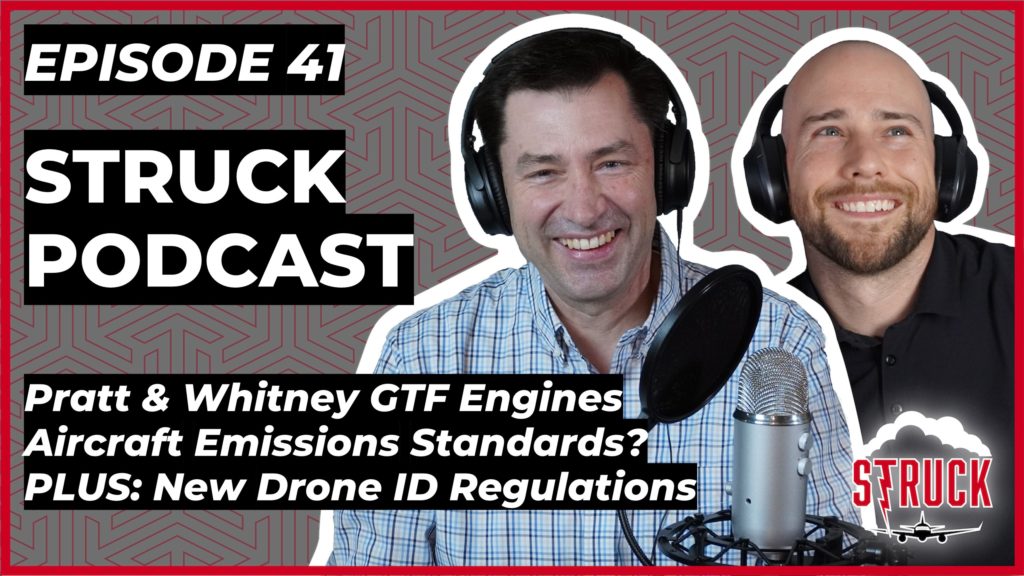In this episode of the Struck Aerospace engineering podcast, we discuss the design of Pratt & Whitney GTF geared turbofan engines – they’re incredibly fuel efficient–what makes them different? We also discuss the EPA’s new emissions rules for commercial and large business aircraft, which will take effect for new designs in 2020 and others in 2028. We also discuss EASA being urged by families to NOT return the Boeing 737 MAX to service just yet, FAA Drone ID Rules, a new Airbus helicopter drone and more.
Podcast: Play in new window | Download
Learn more about Weather Guard StrikeTape segmented lightning diverter strips. Follow the show on YouTube, Twitter, Linkedin and visit us on the web. Have a question we can answer on the show? Email us!
Transcript EP41 – Pratt and Whitney GTF Engines, EPA Aircraft Emissions Standards, & Will EASA Let the 737 MAX Fly?
All right. Welcome back to the struck podcast. I’m your co-host Dan Blewett. On today’s episode. We’re going to cover first in our new section. Uh, families are urging. Yassa not yet to approve the seven 37 max, even though it seems like a return to air worthiness is, uh, obviously right up upon the European union, the seven 37 is back in service in the U S but families are still urging.
So we’ll talk, uh, talk a little bit about that today. Uh, the EPA is finalizing the first ever airplane emissions rules, which sounds like a good thing on the surface. Uh, but Allen’s take here, I think is, uh, A little bit, not surprising, but it’s an insider’s take. And so we’ll chat a little bit about why, um, EPA emissions rules for airplanes might be a little misleading and maybe not be the best thing.
Uh, all things considered and our engineering segment. We’re gonna talk about Pratt and Whitney engines. Um, there’s a new factory North Carolina. And, uh, they’re GTF engines have gotten really high, high marks on reliability. So we’ll chat about some of the technology there. And lastly, on our EBTL segment, we’re going to talk about the new FAA drone ID rules.
So these aren’t, these are obviously EVTOLs, but not in the traditional sense that we talk about in most of our episodes, but this is a really interesting thing. And it’s going to be important as the drone, uh, capacity increases in the airways. And lastly, the Airbus drone VSR700, uh, I was getting pretty close to landing on Navy ships, which is a, apparently a pretty interesting feat of engineering.
So Alan, let’s start with EASA and these families over in Europe who are urging, um, the certification organization to, um, delay the re-entry of the 737 max. So is this. Pretty typical after a crashes like these after a safety situation like this, or is this, um, is it atypical more and more common? I would say that the families take more legal steps against the aircraft companies and against the certification authorities to speak in saying that, uh, they have a say in the certification process and, and are, are trying to push additional.
What they would believe to be additional safety measures onto the aircraft? Uh, the one in particular is they would like to see a third angle of attack sensor used on the 737. The latest update from all the safety reviews is that they’ve added a second AOA or the cross comparing the AOS that they have on the aircraft right now.
So that if there’s some dispute one’s not working correctly, it’s going to flag it and it’s going to. Therefore disengaging them caste system, the updated and caste system, but they think they ought to have a third one there as a compare for the other two. And, um, there’s regulations set up about that and about the reliability of that system and what the failure modes are.
And. The families just disagree now, will that stop EASA from moving forward? I don’t think so. Uh, unless there was some political reasons to use the families in, in leverage that to delay the start of the 737 max in Europe, which they could clearly do. But I think on the certification side, I don’t. I don’t think there are any hurdles besides essentially pilot training at this point and what that pilot training looks like.
Uh, and how many hours of training that looks like, and, or is it, how is that going to be accomplished? And is there any other, uh, pilot related issue that the EASA or the other certification authorities want to address? As the door is open right now, because once the door closes, everybody goes off and starts to operate in the aircraft.
It’s gonna be hard to undo that. Um, so we’ll see what happens here. I’m just, it’s really hard when you have families involved. Um, they don’t know a lot about aircraft design probably. And so what really happens? You have lawyers and from. Watching this a couple of times, it’s part of a larger strategy, probably unfortunately, um, and lawsuits.
So if they get the, if they get this certification authority to, to disagree with the latest update to the seven 37, does that help them in court for lawsuits? Probably. Probably does. Um, so let’s see how this one plays out. It’s just really unfortunate because both, both things have to happen and you’re going to have the lawsuit.
You’re going to have that play out through the court system. Um, you just going to play through the court system, but at some point some 37 has been around for a long time. Is it really all that safe, unsafe, or is it just this one system? Is it just this one system because of having problems with the angle of attack sensor or pilot training, who knows?
But, um, I doubt this is going to push the seven 37 back too far. In Europe. I really doubt it. I think they’re pretty much there right now. Yeah. Well, and they also called into question the FAA, the FAA is decision, uh, read the Senate, uh, committee’s report. So they’re like, Hey, this report just came out and it was pretty ugly.
So sure. We want to go ahead and do this, which I guess that’s a valid point of view and it is a little strange, you know, considering like, Oh, this smallest plane is back in action and we’re all good to go. Like, you know, that phase sort of said. We’re fine. And then the FAA is coming in after that angrily a scolding them some more that I do.
I do find the order of operations. They’re a little strange, obviously, you know, th the Senate report had nothing to do with recertification with the FAA. No, but you know, like I said, it’s like, you build a house and you’re done, and then someone starts pounding on the door about how unsafe it is. Right.
It’s like, well, everyone else signed off on it. So what are we doing? But, yeah, I understand. There’s a lot of emotions and there’s a lot of, there’s a lot of complexity to what’s going on in the court system with the families. And it’s a, it’s a tough situation for everybody. I’m sure. Just to say, it’s almost like you’re, you’re releasing this, you know, almost like you’re releasing a killer from prison.
I don’t know if that’s really the right way to put it, but that’s maybe how it feels a little bit to them like this sure. Family members from us, and you’re letting it back in the wild. Like, are you sure? So like I get that. Yeah, I get it. But, but I feel like I’m lately, I’m always on the side of the FAA way too often here, the FAA is doing a very, very difficult job and they’re stuck in the middle between politicians who can kick them all the time and the industry, which is trying to satisfy them.
So you’re kind of in this, at the FAA, you’re in this like no win situation or at the same time, your goal is to improve air traffic and air or safety. Right. And no matter what you do, there’s always going to be some problem somewhere in this big. Big world of ours and all the airplanes that are flying today.
There’s always going to be some aspect which isn’t going as perfectly as someone else would want it to be. But I think at the end of the day, you know, the FAA has been doing a really good job for a long time. It doesn’t mean that they can’t make improvements, but gee whiz, um, There’s a lot of positive things that are going on in aircraft safety.
And if you watch over the last 10, 15 years, there’s been really remarkable steps and increases in aircraft safety and performance and all the other things we’re gonna talk about today. Those are only possible. Really with having a functional FAA that can work both sides. So, yeah, it’s tough. It’s really, yeah.
Tough. So moving on the EPA is a about to finalize emission standards for commercial aircraft that are either large business jets or. Commercially, uh, you know, commercial airliners, um, and critics are saying that these standards are not soft enough, that they’re going to be quickly outdated. Um, and of course these is the first ever, uh, compliance rules.
Um, but Alan, your, your take on this is a, I think a little unorthodox because you’re, uh, an aerospace insider. Um, does the EPA have business. Regulating airplanes. Now we know that they too cause a lot of emissions, but you’re saying that they’ve been reducing emissions for many, many years now, is that trend going to continue?
And is this really necessary? The aircraft industry in general has been reducing emissions and increasing efficiency dramatically since the start of aviation. That’s the only thing that they have done consistently is aircraft have gone further. Faster with less fuel burn and taking more passengers, uh, per gallon of fuel than ever.
And it’s just, it’s been a steady progression in that direction. And I know we’re going to talk about the geared turbofan from Pratt and Whitney, which is another huge leap of innovation. Why are we kicking the aircraft industry? Because it is set up fundamentally to use less fuel, to get more passengers, moving more miles.
That’s the ultimate goal. If that’s what all the electric, vertical takeoff and landing aircraft are all about. And I know this doesn’t obviously don’t apply to them, but essentially without the EPA, the industry is moving in direction. You want it to anyway, it’s going to naturally because there’s the cost of fuel is such a big.
Player in operations of aircraft that any significant, uh, improvement in terms of aircraft involves engine efficiency or aircraft efficiency, it’s just natural to the system. So why do we need this external force poking, poke yet and making it. Difficult. I don’t understand what people go to bed at night thinking, well, the EPA has passed a rule.
Therefore, the world’s a better place. That isn’t what happens here. What happens here is, is that there’s natural market forces that play into the design and development and the operation of aircraft, which forced it to be more efficient naturally. So. At what point do you say EPA steps in and essentially in theory, I think in theory by 2028, depending on the size of the aircraft, your aircraft could be banned on some level because that’s a little vague when you read the articles, it’s a little vague, but if I own a, to say I own an older Gulfstream aircraft, like a G2 or G three in 20, 28, is that aircraft need to be re-engineered.
Cause that’s not the cheapest thing in the world to do call it call million dollars. Right. Right. So I’ll just make craft value go probably to close to zero immediately. If, if I can’t, cause I won’t be at will probably won’t be able to sell it. It’s like in California, I think there’s those restrictions on what kind of vehicle you can purchase in California based on the environmental regulations there, you can’t bring in a car and I don’t think you can bring a car in from the outside necessarily an operate in California.
If it doesn’t have the emissions equipment to operate there. So you’re kind of setting up that same situation in aircraft, which has really never been there before. There’s been noise rules for a long time, but as that’s been grandfathered, a lot has been grandfathered, but the, the carbon, essentially the carbon dioxide emissions are going to be monitored.
Why, what purpose of that, sir? I think 3% of, of, uh, carbon dioxide emissions come from aviation. The vast majority of those is probably on the, you know, like the Airbus, Boeing type aircraft, right. The business check. Can’t be that much into that mix. I wouldn’t think, uh, so what are we doing? Are we going to crush the industries that already exist that are already working towards better aircraft or re or are we going to, what is the point?
I just don’t understand the point right now. Now is this maybe just like a, a ploy to get. You know, at manufacturers to start moving towards hydrogen engines a little faster, or is it just sort of like to start to maybe box companies like Pratt and when Pratt and Whitney and GE and a little more to say, all right, well, maybe it’s time to just abandon traditional jet turbines as it is.
And just like really start to put more. Money into hydrogen fuel cells, or it could be anything like that, or they’re just starting negotiating with a standard like this. So yes, you’re picking winners and losers on some level you’re picking winners and losers. And I don’t think the government has a very good track record of doing that.
Now, if you want to talk about a hydrogen system. Awesome. But there’s a lot of technical hurdles that are going to be involved in that 20, 28. Isn’t nearly the amount of time for that to happen that will not be done by 2028. Uh, the, uh, Other types of technologies that could be forced on the industry are not developed either.
And there’s a, there’s a lot of different from biofuels to, uh, the power of X, uh, systems that we’re talking about in terms of creating a fuel from the, from, from the air. And there’s just a lot of different ways that to, to, to answer the question, obviously, Everybody in engineering knows that we want to have less emissions.
We live in the world too. Why wouldn’t we want that? But there’s there’s comes certain limitations, particularly when you’re introducing a new technology, you may be making the aircraft less safe. So are you okay with more crashes? Because you have a cleaner, quote-unquote a cleaner environment or less CO2 in the air.
That’s the kind of trade-off we’re talking about here. And there was no engineer worth their salt. That’s going to say I’m willing to kill people to make a 0.001 Inc. Decrease in carbon dioxide emissions. That ain’t going to happen. So at some point you got to get some, get to the real part of this, which is Boeing and Airbus.
Aren’t not going to play around. If they can’t deliver an aircraft, then they have the, the might in Europe and the United States to stop whatever regulation that exists or would exist. Right. So obviously Boeing and Airbus have blessed whatever’s going about to happen. Uh, the larger aircraft companies like Gulf stream, Bombardi EA, uh, Embraer.
Must have must agree to this because if they didn’t, they’d be fighting it tooth and nail. So on some level, the aircraft industries have probably bought their way into this regulation. But what are we doing to possible? Do entries? Are they restricting things we haven’t thought of before? Because the industry, the aircraft industry is about 117 ish years old, roughly.
And from that point, we’ve come from a single pilot propeller airplanes to supersonic aircraft, to aircraft that can fly literally around the world. A little over a hundred years. That’s crazy, but we’ve never really put in, put these kind of odd restrictions on emissions before. Cause we haven’t, we don’t really need them.
I think that’s the thing is that we don’t really need those restrictions. The industry itself will go on the right direction. Leave it alone. Monitor from the outside. There are other places to go push for carbon dioxide emissions in the United States has reduced carbon dioxide emissions. Uh, over the last 10 years have been a decreased nationally in the United States.
That’s going to continue probably when you think jerk reaction. Yeah. I mean, I just, everyone right now is able to have a voice right. On the web. And so I think people are like, well, all the people who really love the planet, which is great, not, not hating on loving the planet, but everyone’s like, well, the airline industry.
I mean, they’re a huge part of the problem. Why don’t we regulate them? This makes no sense why they’re not getting regulated. It just seems like a quick knee-jerk reaction, but right. You know, to your point that this, that aviation is really important for human movement around the globe, much more so than, um, I guess, I don’t know if we could say much more so than cars, but it’s.
It’s been a huge part of transportation around the globe. Um, it has can’t drive across the Atlantic. You’re not driving across the Pacific, right? At some point you need an airplane yet. Not yet. Right? We still need airplanes to go do these things into, to move traffic from Asia to the United States overnight.
There was only one way to do that. So are you willing to give that up and do you really realize what the consequences of that mean. It basically means people die. That’s what it means. It means it takes longer to develop vaccines. It takes longer for everything to occur. Are we willing to give that up for, uh, like I said, a very, very, very, very small fraction of CO2 emissions that are going to be possibly reduced by this doesn’t sound like a valid trade-off because there are.
Consequences to these decisions. You need to weigh the costs and benefits here. Have we waived the costs? I don’t think so. I don’t think so. And like, like I said, it seems like people just like, well, why shouldn’t everybody, that’s not fair. Everybody should be regulated. And if cars have to, then, you know, planes should have to.
Well, like you said, it’s more, it’s more complex than that. And I don’t think a lot of people, not a lot of people wouldn’t even realize it. I wouldn’t realize it if I was just reading this and, you know, weren’t, you know, given your knowledge on a, on a weekly basis, like, I wouldn’t know, I’d be like, Oh yeah, that makes sense.
They’re a big contributor. They should be regulated. Done deal. Right. But when you’re an outsider, it’s easy to say that it’s easy to say it. Yeah.
So moving on to our engineering segment here, we’re gonna talk about Pratt and Whitney. So they’re GTF, uh, they’re geared turbofan engines are powering. Uh, it looks like about 900 aircraft right now. Uh, they have a new factory, um, in, uh, North Carolina. And, um, so the Airbus a320neo is power powered exclusively by, um, Pratt and Whitney GTF.
Turbofans, uh, the Airbus 82 20, the Embraer III jets and, um, you know, Pratt and Whitney, which is owned by Raytheon. They’re touting that just again, which we were just talking about. They’ve saved more than 400 million gallons of fuel and over 3.8 million metric, tons of carbon emissions. So like you said, They’ve been doing this unregulated they’ve been doing on their own because they just want to make more fuel efficient aircraft so that they can save money, be more profitable.
Yeah. So it all makes sense. Um, which is just very different than. Know a car because you can get from point a to point B in a car and no one really cares. Right. Um, you know, if you’re guzzling 10 gallons of gas, but when you’re your business depends on reducing fuel consumption. Cause it’s getting so expensive.
It makes a lot of sense to just start, Hey, how can we be more fuel efficient? And as we talked about in an earlier episode, you know, like, Planes are, and an airlines been swapping out engines to do this. So like, Hey, let’s get those more fuel efficient engines. No, one’s telling them how to do that or that they have to do that.
They just want to do that. So what’s unique about the, uh, the Pratt Whitney GTF series. Cause they’re, they’re seemingly a pretty unique, um, turbine engine. Sort of fundamentals of, of a turbofan engine. You’ve got this gigantic fan of the front, then you, which is what they call the cold section. And then you have this sort of hot jet engine section behind it, uh, that fan that you see when you get on an airplane.
And if you’re looking at. Engine inlet. You see that big fan in the front, that fan is actually driven via shaft as part of the jet engine inside. So the back end of the jet engine is shafted all the way to the front to spin that fan. So we’ve just sort of part of jet fundamentals here is that the, the more efficient you make that fan in the front, the more efficient your engine is.
The problem is with the. General layout is the hot section. Back in the back of the engine. He wants to spend at a certain speed to be very efficient and for the front fan to be efficient, you need to spin at a slower speed, but that’s where the gearbox comes in now. From a engineering standpoint and on the back of an envelope.
Oh yeah. If you can get the, if you can basically put a transmission in this engine from the hot section to this cold section out front, you can get a lot more bypass, uh, or a lot more, uh, thrust, a lot more efficiency. And you also know that when you put more cold air, which do you have a larger fan upfront and it’s.
Moving more mass. It’s not moving it as quickly. The fans aren’t moving as quickly, but they’re moving more massive air with every sweep of the blade that, that air, when it runs back over the hot section of the engine makes the engine quieter. So you’ve got this double effect of reducing emissions, noise emissions, but also having a very efficient thrust system.
The problem is that that transmission. Has to handle thousands of horsepower and be reliable for 20, 30 years without ever breaking down. So to create that transmission in the middle of this engine was always the problem that because of the complexities of that system and their, how reliable it had to be, particularly on twin engine aircraft that are flying over water.
For example, you, you, you can’t have that section fail and it was. Basically quasi brand new technology and Pratt and Whitney struggled with that with, for a long time. I know they had worked with NASA to develop parts of it and to come up some of the conceptual pieces of it, but Pratt and Whitney put their, essentially their engine company on the line for a long time to develop that, that transmission section, the gear turbofan.
And they had problems early on. They had problems with that engine, uh, because of the complexities of it. But like most engineering projects, if the physics and the fundamentals are right, you can kind of work through the details. And once you develop the, uh, wherewithal materials and, uh, all of the engineering improvements particularly cause you can machine things.
So finally today you can make this transmission. So th the, the numbers tossed around, I was watching a little Pratt and Whitney video talking about this, or what the fuel savings were per airplane per year. It’s about a million bucks a year in fuel cost reductions. Using these engines. You’re like, wow. A million dollars per year per airplane.
That’s a lot of money, a hundred million dollars for a Southwest fleet. I mean, I’m out of how many planes Southwest is flying, but yeah, I mean, quite a few, right. A couple hundred, I don’t know. Yeah. A couple hundred dollars savings. Yeah. Right. So the, the right a320neo that has those. These engines on them, a very popular airplane today because of the fuel burn, right?
Th th th they had some trouble early on, and I think they ended up grounding a bunch of neos early on because of the, I think there was issues in the hot section with it, not necessarily what the geared section, uh, and Bombardia had trouble early on, on the C series, which is now the two 20, uh, with some oral retention issues.
But they’ve worked through those issues and it looks like that technology is going to be a way to go forward and you’re going to see the other engine manufacturers develop something like it’s, uh, uh, whether it comes to market, they’re not, we’ll see, but that is an engineering Marvel. It may seem simple when you’re sitting in the airplane, looking out on the engine and go new engines, but it took Pratt and Whitney literally 20 years to develop this thing.
And we just take it for granted. Right. We just take it for granted. We get on the airplane that they don’t think twice about it. Meanwhile, People’s whole careers, whole engineering careers, or were working only on that. That’s crazy to think about, right? Yeah, exactly. Right. Yeah. So w when we talked about the EPA controlling or putting regulations out, you think you could just wipe out people’s whole lifetimes with that, because that’s a, and it’s a huge risk for Pratt and Whitney.
It’s a huge risk. If you look at the articles that were written. 10 years ago about the gear turbo fans or 15 years ago, like this is impossible. This is going to be the downfall Pratt and Whitney Pratt and Whitney can’t afford to keep paying money into the system. This is never going to come into fruition.
Yeah, it was a huge risk because no one had ever done it before, but. Now that’s been in service for a little while, and now we’re finding out their liabilities pretty good. And that we are making those fuel savings that we thought were going to make, and everybody’s starting to be happy with it. And the industry will change over time into those types of technologies.
We’re going to be able to squeeze engine technology to places we never thought possible because it didn’t have. The skill set to go do it. And now that we, and now that we’ve shown a Pratt, Whitney is shown and NASA is shown, and some others have shown that this is possible, just opens the doors to other type of fuel burn savings.
And it just, this is a remarkable feat. I don’t know if everybody gets it, but this is a remarkable feat and we just take it for granted. Super frustrating. Getting choked up. Are you going to sell it to you for this? It does. This is the thing about aircraft, right? When you, when you decide to work on an aircraft program, you pretty much kiss away five years of your life, straight up, maybe 10.
So by the time, if you start on an aircraft program and new Yorker program, like it’s in development, it’s not publicized and you’re back in the back and you’re working on the design. You on a clean sheet of paper and you want to ride this thing out to the end, you’re going to eat up, consider a part of your life doing it.
And so if it doesn’t come to fruition, kind of seems like a loss, doesn’t it I’ve been on a couple of different aircraft program that never came to fruition. And it feels like someone stabbed you in the heart. That’s what it feels like because you, you know, that that, that aircraft could, could work, but there’s a lot of variables there.
The economy being one of them, the government being another one of them and to lose the ability to bring something to market that probably should be there is really tough to swallow. And when things like this or Pratt and Whitney basically makes a miracle happen, um, we just don’t give it the recognition in which it deserves.
I think. All right. So in our final segment here, we’re going to check quickly about a little bit of EBTL news first and start with the Airbus VSR 700 drone helicopter. So this sounds like another one of those same projects, Alan, what that you said it’s been historically very difficult to land something on an aircraft carrier, like lent you’re landing on a moving target, right?
So they have these moving deck systems to simulate the movement, like the role in the, in the pitch of a, of a ship at sea. Um, but Airbus is apparently getting pretty close to having a tactical unmanned aerial system, um, with autonomous take off and landing. There’s an article from aviation today, uh, being able to land on one of these flight control decks.
So how, I mean, this is, this sounds like another one of those really long. Problems it is. Um, but it sounds like it’s getting close to coming to fruition. It was because the computational ability, uh, we can shove it to an aircraft of any size is getting so, um, so complex and capable. I always relate this to the autonomous driving car.
If we can have a car drive itself and. Safely down the road, see stop signs, see speed markers, all that stuff. Uh, that same level of skill set can also be applied in aviation. And the th when you land, while you’re trying to land a moving. Aircraft in the wind, uh, in, in turbulence, on a ship that’s moving up and down and left or right.
Uh, that’s uh, one of the hardest control law problems to solve because we’re stuff happens. And so they’ve been working on that technology for a number of years. A lot of companies have actually been working on that kind of technology for a number of years because it has applications all over the place.
Um, Life-saving applications actually. Uh, so the see that Airbus is progressing with it is really good because it’s, again, one of those interesting projects, it needs to get solved. It’s kind of like a space X landing, their rocket back on a pad on land. Right. But first I guess they landed it on a ship.
Right? So, uh, the space that group is. Kind of work that problem a little bit, but they all had a bunch of failures early on, and any aircraft comes is going to have some failures or the Onyx is a very difficult problem to solve. It’s one of those hardest, one of the Harbor control problem laws to solve and do it reliably.
And that’s what we’re talking about. So I do think this is a big advance. They will get it. It’s just gonna take a little bit of time and proving it out because it’s not that you can do it once or twice, or like the space X thing. If one of these rockets tips over and falls over and explodes, it doesn’t seem like space X even cares.
But if one of these helicopters tips over on an aircraft carrier full of sailors and airmen and hurt somebody. It really matters. Right. It’s just not a lot of room to move on a ship. If one of these things go wrong in a cell, a copter. Yeah. Let’s go over a rotor. Someone’s getting hurt. Right. So the safety is, is that most important?
And so last topic for today. Speaking of safety, the FAA, um, has released final rules for remote ID, which is going to control drone operations, um, over people. And so basically all these drones are going to be, uh, forced to sort of register with a digital license plate. That’s going to project, um, you know, uh, an identifier so they can be easily Aidid by, um, you know, officials.
Someone flies it near an airport where they’re in, you know, no flies on airspace right here in DC. And you can’t fly a drone anywhere within 25 miles of Reagan. Airport is the most restricted part of the country. So they’re now going to have a very easy way of knowing if you break those rules. And of course, a lot of drones like DJI, And I think this is probably most of them won’t let you fly.
Like they won’t take off and restricted airspace. Like I own a drone, it will not take off right. Since I’m within that airspace. So they do have some controls now, but obviously people are very tech savvy who enjoy drones some more than others. I’m sure they can hack that system and change it and, uh, or to build their own drone.
Right. And go rogue. Um, so obviously we don’t talk about like, Consumer handheld drones that much, but it’s a really popular thing it’s growing in popularity and there’s going to be more and more encounters with people flying these around places where a plane could be or just injuring people. Obviously, Amazon is.
Hoping to deliver packages by drone, some point. Sure. Other companies will fall suit. It seems like a reasonable endeavor. Sure. Potentially delivering medicine, you know, to remote locations. Sure. Um, there’s lots of applications. So alums, this seemed like a reasonable step forward. I think so. There’s a local modeling club nearby.
And I saw some traffic off of all things, Facebook, which I rarely look at. Uh, but I was curious to see what the local bottle club modeling club was saying about that. And the comment on Facebook was, Hey, these restrictions aren’t as bad as they thought we thought they were going to be. So. We could probably get by with them.
And I think at the end of the day, 99%, almost practically a hundred percent of people that are owning and operating a remote model aircraft or drones are doing it responsibly. It’s that small fraction of a fraction of a fraction that does something stupid. And then the whole, all the whole lot gets tossed into things like this, where you got to now have a.
Digital license plate I did here. Over the weekend, there was discussion online. I think it was on YouTube where they’re talking about a, um, a drone operator down in the Philadelphia area had posted a number of videos on YouTube of, I think there is operating around the Philadelphia airport. If I remember correctly and the FAA saw those YouTube videos and sent him a bunch of fine notices for each one of those flights.
Because he had posted them. Ah, wow. Yeah. Who’s watching it, the FAA to make sure this is going on and maybe YouTube telling, I don’t know, but it just seemed like, wow, there’s a lot more oversight on what’s going on with these drones. And I thought there was because I’ve seen a lot of drone video that.
Looks wrong to me. That’s still on YouTube and the discussion revolved around, um, uh, the statute of limitations and when they could come get you or not, and the advice was, if you’re gonna do something stupid like that, wait till the statue of limitations passed before he had posted it to YouTube, which I think the better, I don’t follow those.
Yeah. I mean, people have been recording themselves, committing crimes. I mean, left and right. It seems like it’s crazy, but yeah, criminals, aren’t super smart a lot at the time. But one of the things that this, that could be scary is that the idea that drones could be used for like terrorism, something like that.
I mean, there’s nothing you need to talk about the Nashville bombing over Christmas. Yeah. There’s nothing preventing someone from taking a drone, rigging it up to carry something, right? Like Amazon wants to carry packages. You carry a package full of explosives and drop it in the middle of someplace.
That’s terrifying. You could do worse things than that. You can do a lot worse than that. Do a lot of really bad things. And so. To have an easy way. And of course, people who would do that stuff would obviously try to circumvent these remote ID rules, but you know, regulation to hopefully ID these. These devices, these drones, it’s going to hopefully prevent some stuff like that from happening.
Yeah. So there’s, there is just no, going back at this point, as you know, the DGI drones are not that expensive and the capability of them, I said, they’re amazing. They know where they’re at. Right. So you can’t walk outside of your place and fly this thing because it knows it’s in that radius where it can’t fly.
So it doesn’t, I mean, how smart is that? I mean, but that just tells you how. Smart these drones and the systems are and how capable they are today. And I know on our wind turbine podcast, we’ve been talking a lot about using drones to inspect wind turbines. So there are very, very useful functions for drones that we need them because it’s taking people out of hazardous situations.
Uh, we just, I think, uh, got stop the people, doing the crazy stuff and putting people at risk and we can move along. All right. Well, that’ll do it for today’s episode of struck. If you’re new to the show. Thank you so much for listening. And please leave a review and subscribe on iTunes, Spotify, or wherever you listen to podcasts.
Check out the weather guard, lightening tech YouTube channel for video episodes, full interviews and short clips from the show. And follow us on LinkedIn, Twitter, Instagram, and Facebook. Our handle is at WG lightning tune in next Tuesday for another great episode on aviation, aerospace engineering and lightening protection.
Strike tape, weather guard, lightning techs, proprietary lightning protection for radomes provides unmatched durability for years to come. If you need help with your radon lightning protection, reach out to us at weatherguardaero.com. That’s weatherguardaero.com.












